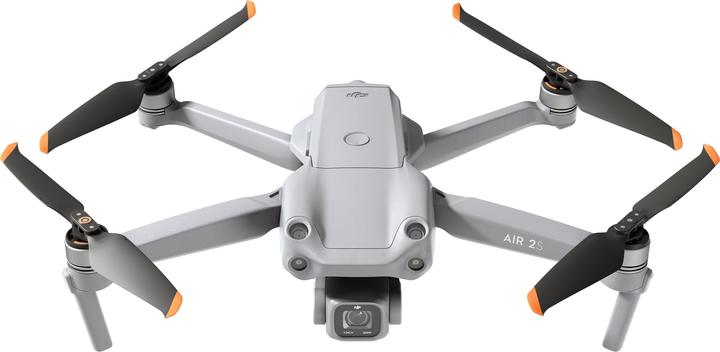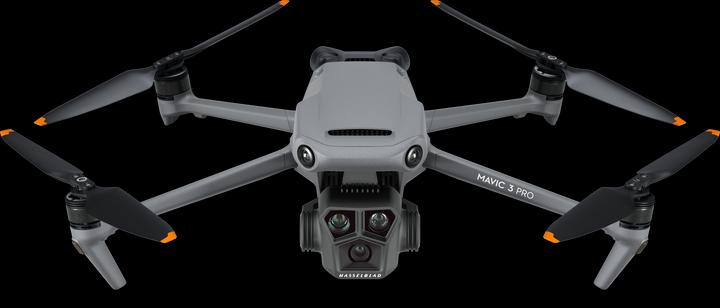
Product test
Hover Air X1 Promax selfie drone review
by David Lee

Two cameras and a longer flight time than its predecessor, but smaller image sensors and heavier: the DJI Air 3 is, at its core, hardly an upgrade. Still, it throws together some familiar features in a sensible way.
The Air 3 is DJI’s new mid-range drone. They’ve recycled familiar ideas and repackaged them. What’s really interesting is the tele camera. I took the drone with me on holiday to Wales and I ask myself: has DJI come to a standstill?
The Air series was my personal favourite in DJI’s sprawling line-up. It’s not too big, not too pricey, but still has good image quality. The Air 3 is different. Size and weight are much closer to the large Mavic series than before. Compared to the last generation, the Air 3 has gained a whole 125 grammes and 2.7 centimetres. Probably because of the additional tele camera and the larger battery.
Here are the most important specifications compared with those of the Mini 3 Pro and the Mavic 3 Pro:
What’s striking is not only the size of the aircraft, but also the size of the image sensors. Both cameras feature the 1/1.3-inch CMOS known from the Mini 3 Pro. In the previous model Air 2S, DJI still installed a larger 1-inch sensor. This was able to record videos with 5.4K resolution, whereas the Air 3 only manages 4K, but at least with higher frame rates. The drone also has more sensors installed and detects obstacles in all directions.
With less light, image noise sets in, so I would avoid ISO values beyond 400. Since the drone can stand very still in the air, poor lighting conditions can be compensated for, for a relatively long time, with the shutter speed.
The Air 3 is easy to use, if you’ve had a bit of practice. It can fly very fast in sport mode, which I hardly use. What I do like, however, is that it can also descend quickly at 10 m/s. At 6 m/s, the predecessor needs considerably longer to reach the ground again from high altitudes.
This is particularly useful for the automatic object tracking. Here you can set the perspective from which the drone should track something – from behind, from the side, or from the front. This works quite well in my tests with the car on an empty road. Although the images aren’t always perfectly smooth when it’s windy and the speed of the object varies.
What’s not so nice is the volume of the DJI Air 3. I measured 77 decibels (dB) at a distance of 30 cm – just a bit less than the Mavic 3, which comes in at 79 dB. That’s a lot, but at least the noise is relatively low-frequency. But a small Mini 3 Pro is much quieter. In the same conditions, I measure 69 dB from that one. The difference can’t be ignored, since the volume is a decisive factor in determining whether people nearby feel inconvenienced by a drone.
The DJI Air 3 is a multifaceted and well-developed drone. The image quality of the main camera isn’t outstanding, but it’s good enough. Compared to the smaller Mini 3 Pro, you get a useful second camera with a 70-millimetre focal length and improved obstacle detection. What I particularly like is that the image sensors of the two cameras are identical. This makes it easier to compare the shots and put them together.
If you often travel on foot, I would still recommend the Mini 3 Pro. The weight of the Air 3 is such a disadvantage that, for me, outweighs the benefit of the tele camera once I have to lug the drone around in a backpack. The Mini 3 Pro is significantly quieter and doesn’t disturb the people around as much.
With the Air 3, DJI is doing what the manufacturer does best: covering another niche. People with specific needs may be happy about the drone, for everyone else it adds to the choice overload. The search for real innovations is unsuccessful. The Air 3 consists of familiar cameras in a new combination on a rather large drone. Not bad, but not inspirational.
My fingerprint often changes so drastically that my MacBook doesn't recognise it anymore. The reason? If I'm not clinging to a monitor or camera, I'm probably clinging to a rockface by the tips of my fingers.
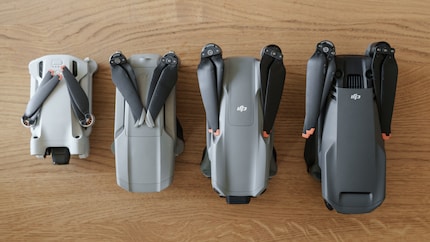
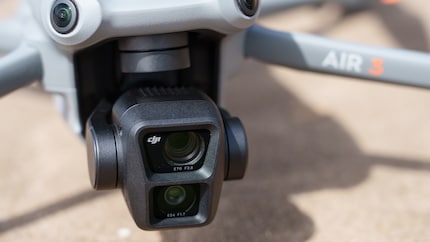
The main camera offers the exact same image quality as the Mini 3 Pro: good, though not outstanding. Photos taken in daylight and RAW format at a 48-megapixel resolution are best. In the 100-per cent view, the limits of the small sensor and the lens become visible; the high resolution doesn’t change that, though you can actually see a few more details than in the 12-megapixel mode. In the standard size, photos look very good and I like the colours.
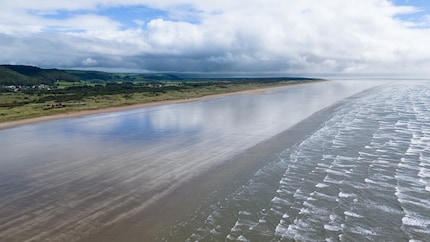

The 4K videos look great too. In addition to the standard colour profile, you can also film in D-Log M. This is a flat colour profile with more dynamic range that you’ll have to grade later when you cut. It’s not quite as flat as the normal D-Log of the Mavic series, but it’s available on both the main and tele cameras. If you want to shoot with the correct shutter angle, you almost always need an ND filter with the Air 3. Because unlike the Mavic series, the aperture is also fixed on the main camera.
You have to buy the filters separately, they’re not included in any combo. They darken the main camera and tele camera equally. A handy feature, in my book. Because while the aperture of the main camera is f/1.7, the telephoto lens only has f/2.8 – so it lets less than half as much light through. If you want to shoot with constant ISO sensitivity and shutter speed, you would have to change the ND filter every time you switch from the main camera to the tele camera and vice versa.
I switched between the two quite a lot – for a good reason: the tele camera also takes great pictures and videos. It’s the same as in the Mavic 3 Pro. The focal length of 70 millimetres (equivalent to a 35 mm film) is super. It makes for a less worn aerial perspective than the perennial wide-angle shots. At the same time, it’s no super telephoto lens beyond 100 millimetres which results in microscopic sensors and is barely usable. Instead, DJI installs the same 1/1.3-inch CMOS here as in the main camera.
The versatile dual camera with consistent image quality is clearly the highlight of the Air 3. On the one hand, I can capture wide landscapes with the main camera. On the other hand, the 70-millimetre lens opens up new perspectives and possibilities such as parallax effects (see video above). If I want to have people in the picture, I no longer have to fly within a few metres of them. This would have made me very happy on numerous occasions in the past when shooting climbing videos.
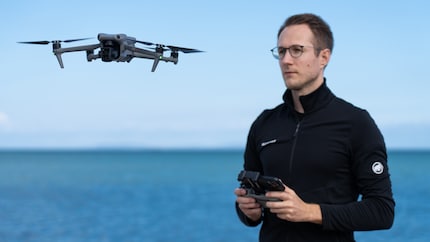
The long battery life is also practical. You’ll only reach the stated 46 minutes in the most optimal case. But even in strong winds, the Air 3 easily stayed in the air for over half an hour during my flights. This is fantastic and means that I have to carry one less spare battery than before. Another improvement is the omnidirectional sensors. They recognise any obstacles at the sides. If you fly in normal mode in good light conditions, you’d have to actively try and cause a collision.
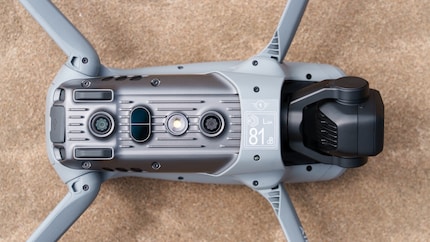
The aircraft stays in the air longer, but is also significantly larger than the old Air 2S. In terms of portability, the advantage over the large Mavic series melts away. It is cheaper, though. If size isn’t an issue, it is my new recommendation in terms of value for money in DJI’s range. But if you want the useful tele camera with a medium focal length on the Mavic, you’ll have to get the «Pro» model. The Pro also has a better main camera and a super telephoto of 166 millimetres. But the quality of the larger sensor is not miles better and the super telephoto lens is practically unusable.

DJI Mini 3 Pro with RC Controller
34 min, 249 g, 48 Mpx
